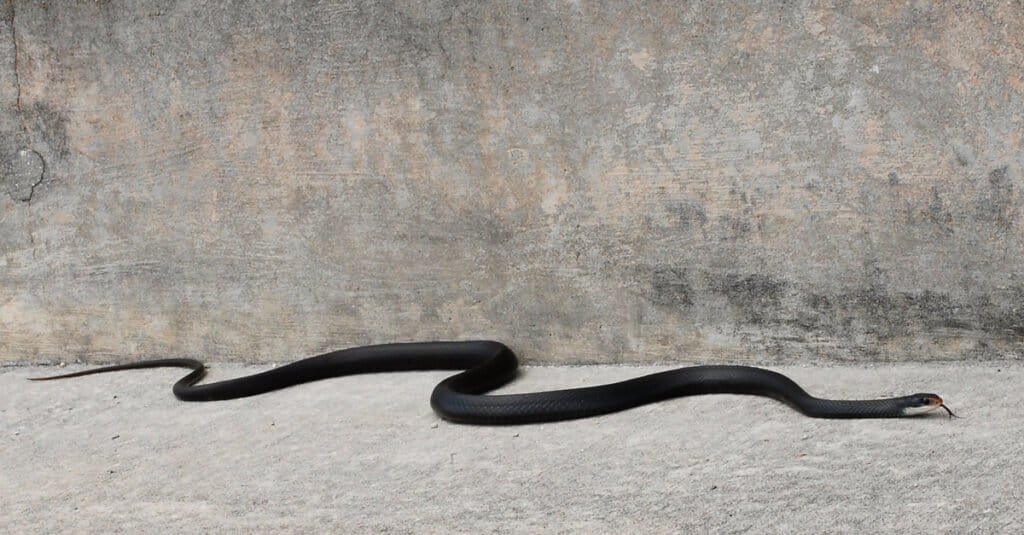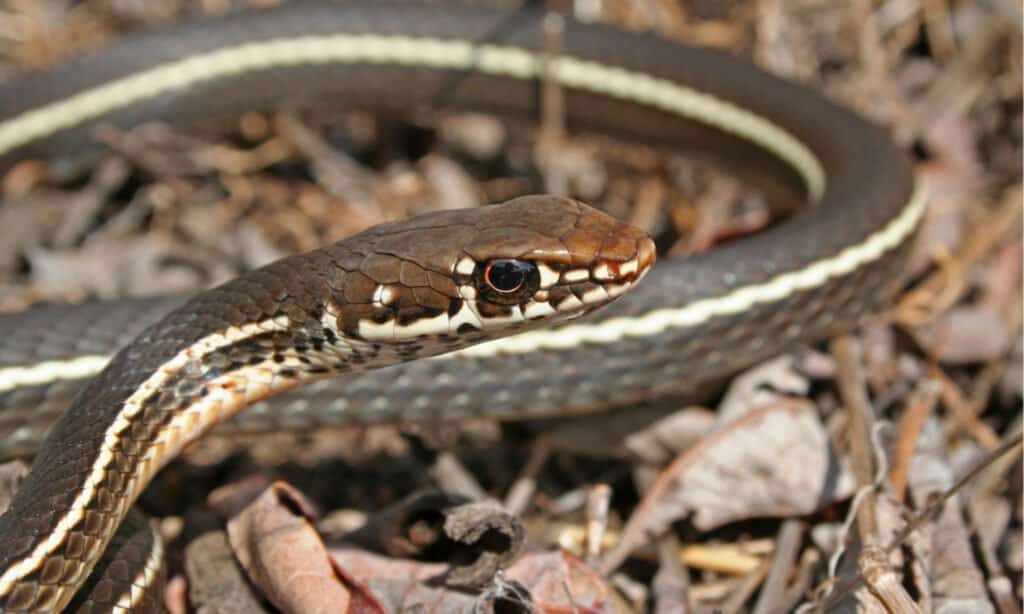Racer Snake
Coluber constrictor
The racer snake can speed away at up to 3.5 miles per hour
Advertisement
Racer Snake Scientific Classification
- Kingdom
- Animalia
- Phylum
- Chordata
- Class
- Reptilia
- Order
- Squamata
- Family
- Colubridae
- Genus
- Coluber
- Scientific Name
- Coluber constrictor
Read our Complete Guide to Classification of Animals.
Racer Snake Conservation Status
Racer Snake Facts
- Prey
- Small rodents, insects, frogs, birds, other snakes, bird eggs
- Fun Fact
- The racer snake can speed away at up to 3.5 miles per hour
- Litter Size
- 4 to 36 eggs
- Diet
- Carnivore
- Common Name
- Eastern racers, black racers, brown racers, tan racers, blue racers, or green racers, runners
View all of the Racer Snake images!
“These great tree climbers are named ‘racers’ because of their ability to dart away from danger at up to 3.5 miles per hour!”
The racer snake, also called the Eastern racer snake, is a non-venomous species of 11 subspecies found in North America and Central America, from southern Canada to Guatemala. Their scientific name is “Coluber constrictor,” not because the snake constricts its prey to kill it, but because it will lie on top of the prey and press down on it with its body. Then it swallows the subdued prey alive.
Although it does not inject venom and is not poisonous as a result, the racer snake often bites humans out of perceived threat. When cornered, it vibrates its tail and strikes out multiple times. If it does not bite, you are more likely to see the racer snake rapidly scurrying away at speeds of up to 3.5 miles per hour. In its confusion, it may accidentally dart right toward you! This is why it has the name “racer snake,” because it seems to chase people and animals that cross its path. They are quick, agile, and excellent climbers that stay active throughout the day. Many people confuse the racer snake with the highly poisonous and sometimes deadly cottonmouth due to its coloring.
5 Amazing Racer Snake Facts
- The racer snake can speed away at up to 3.5 miles per hour.
- The female racer lays up to 36 eggs at a time, sometimes into a communal nest with eggs of other snakes.
- Non-venomous and therefore not poisonous, this snake will still attack humans by biting several times in quick succession if it feels cornered.
- There are 11 subspecies of racer snakes in North America and Central America, each varying in adult colors and juvenile snake patterns.
- They are great tree climbers and often go into trees to scavenge bird eggs and even small birds like finches and canaries.

Where to Find Them
The racer snake is one of the most commonly seen snakes in North America and Central America. This is because they often live in urban areas alongside humans, such as in garbage heaps, along roadsides, and even in residential neighborhoods. In fact, it is the most often seen snake in neighborhoods of Florida. Still, the snakes have preferences in where they live, such as near water, on open grasslands, in forests, and in semi-arid regions. They thrive around swamps, brush, shrubs, and trees where they can hide undercover. The snakes also climb trees in search of small prey like bird eggs, baby birds, adult finches, canaries, or thrashers.
Within Canada, racer snakes are found in Alberta, British Columbia, Ontario, and Saskatchewan. In the United States, they are found in every state. But they are least common in New Mexico, Arizona, Minnesota, Maine, and the northernmost portions of New York, Vermont, and New Hampshire. In Central America, they are found in mostly the eastern parts of Mexico, Belize, and Guatemala.
The mating season for racer snakes is April to June of each year. During this time, they may seem more visible than during other months or seasons. Juveniles hatch in early fall, after which they are often seen. Juveniles generally have patterned coloration that becomes solid as the snakes age into adulthood. Humans often kill the non-poisonous and even harmless racer snakes, usually because they look so similar to cottonmouths that are so feared for their bite. As a result, you can often find eastern racers dead in populated areas. They are often hit by cars on highways and even on neighborhood streets.

Racer snakes are one of the most commonly seen snakes.
©iStock.com/sdbower
Types of Racer Snakes
There are 11 subspecies of racer snakes. The collective species, under the scientific name Coluber constrictor, are commonly called eastern racers. Together, all of these 11 subspecies make up the genus Coluber.
The 11 Coluber constrictor subspecies include:
- Blue Racer (Coluber constrictor foxii) – The Blue Racers have a beautiful blue coloration live in Wisconsin, Iowa, Ohio, Michigan, Indiana, and Illinois, as well as the Pelee Island of Ontario. They prefer to live far from humans and are frequently prey to domestic cats and dogs.
- Western Yellow-bellied Racer (Coluber constrictor mormon) – Also called the western racer, the Western Yellow-bellied Racer lives in California, Oregon, Nevada, New Mexico, Utah, Montana, and Colorado. Its dorsal side is brown, green, or blue with a yellow underside.
- Mexican Racer (Coluber constrictor oaxaca) – Found mostly in Mexico, Mexican Racers can also sometimes be found in Texas or Guatemala and measures only up to about 40in in length.
- Eastern Yellow-bellied Racer (Coluber constrictor flaviventris) – As its name implies, the Eastern Yellow-bellied Racer has a yellow belly. Its dorsal side is olive gray-green. The snake lives in Montana, North Dakota and South Dakota, also ranging as far east as Iowa and as far south as Texas and Louisiana.
- Buttermilk Racer (Coluber constrictor anthicus) – Found in Louisiana, Texas, and Arkansas, the Buttermilk Racer is patterned with colors of black, gray, green, blue, yellow, and white in adulthood.
- Northern black racer (Coluber constrictor constrictor) – The Northern Black Racer lives throughout the eastern U.S. and as far west as Ohio and Kentucky. Its range adjoins that of the southern black racer and the eastern yellow-bellied racer.
- Tan Racer (Coluber constrictor etheridgei) – The Tan Racer, a tan-colored snake, lives only in the pine Flatwoods of Louisiana and Texas.
- Brown-chinned Racer (Coluber constrictor helvigularis) – The Brown-chinned Racer has a telltale light-colored chin and lives in the panhandle of Florida.
- Black-masked Racer (Coluber constrictor latrunculus) – Varying between gray, blue-gray, and brown in color, Black-masked Racers have a black marking extending from each eye to the back of its head. They live in Mississippi, Arkansas, and Louisiana cypress swamps and wooded bottomlands.
- Everglades Racer (Coluber constrictor paludicola) – Named for the Everglades of Florida in which they live, Everglades Racers feature gray to olive dorsal coloration.
- Southern Black Racer (Coluber constrictor priapus) – The Southern black racer is one of the most common of the species, found in southern states of the U.S. It is mostly black in color with a light chin.
The red racer snake, also called the coachwhip, is a closely-related snake not in the same genus as the 11 eastern racers. Instead of being in the genus Coluber and family Colubridae, the red racer is in the genus Masticophis of the family Colubridae. This swiftly-moving snake shares many characteristics with the eastern racer snakes. But the red racer is 0.5mph faster in speed and longer in size than an eastern racer. The red coachwhips also prefer sandy regions and pine forests for their habitat.
Similarly, another “racer” type snake is the California whipsnake (Masticophis lateralis). This snake is not an eastern racer subspecies and is actually more closely related to the “red racer” coachwhip. The California whipsnake is in the genus Masticophis with the coachwhip, in the same family (Colubridae) as the Coluber constrictors. Masticophis lateralis is easily differentiated by its dark green to black dorsal coloration with a vibrant yellow stripe on each side, from head to tail. The whipsnake is also smaller in size than most adult racers, measuring only between 36in and 45in long.

In the month of October, the southern black racers go underground into dens containing other species of snakes.
©Perry Correll/Shutterstock.com
Scientific Name
The eastern racer snake (Coluber constrictor) is a species of 11 alternately-named subspecies. They belong to the family Colibrudae and class Reptilia in the order Squamata. “Coluber” is the Latin term for “snake.” “Constrictor” refers to the snake’s actions when hunting and eating its prey. But that term is confusing, in that the racer snake does not “constrict” its prey to suffocate it by coiling around it as boa constrictors do. Instead, the racer places its body on top of the prey to subdue it by exerting body weight and light pressure. The racer usually consumes its food while the prey is still alive.

Racer snakes belong to the family Colibrudae and class Reptilia in the order Squamata.
©werg/Shutterstock.com
Population and Conservation Status
The population and conservation status of each of the 11 racer snake subspecies vary. The conservation status for the snake species overall is listed as “Least Concern” and “Stable” as of 2012 by the IUCN Red List of Endangered Species. The IUCN also lists the population count as unknown but likely exceeding 1,000,000.
According to NatureServe species tracking, there are some problems with the snake’s conservation in some regions. Problem regions for racer conservation include:
- Arizona, USA – Critically imperiled
- Alberta, Canada – Critically imperiled
- Ontario, Canada – Critically imperiled
- Ohio, USA – Critically imperiled
- New Hampshire, USA – Critically imperiled
- Wisconsin, USA – Imperiled
- Maine, USA – Imperiled
- Saskatchewan, Canada – Imperiled
- British Columbia, Canada – Imperiled
- New Mexico, USA – Vulnerable
- Minnesota, USA – Vulnerable
- Vermont, USA – Vulnerable
In California, Florida, and multiple other U.S. states, the status of the snake is unknown.

Racer snakes are generally under the Least Concerned category of conservation status, but in some regions, there are some issues.
©Creeping Things/Shutterstock.com
Appearance and Description
Racer snakes from all 11 subspecies are generally solid colored as adults, most often ranging between colors of brown, green, olive, gray, blue, and black on the dorsal side with a lighter colored underside. But in many regions, such as where the southern black racer snake predominates, the animal looks very much like a cottonmouth. Also called a “water moccasin,” the cottonmouth is one of the most venomous snakes in North America. For this reason, there is little time for humans to identify a non-venomous racer snake before fear can take over. The quickest method of differentiating the two is to look at the snake’s head. A triangular-shaped head is a telltale indication that the snake is venomous and possibly a dangerous cottonmouth. An oval, unpronounced head shape can quickly indicate the snake is a common and non-venomous racer.
Racer snakes are long and lean, measuring up to 60 inches in length. They can come across as mildly aggressive if they are cornered or startled. In such cases, the snake often resorts to lashing out at the humans or animals making it feel threatened. It will vibrate its tail and may lash out repeatedly in quick biting actions. Although it bites, the snake does not have fangs with venom and will not cause harm. The racer’s actual preference is to flee the area of the perceived threat. It can slither away as fast as 3.5mph.
Juvenile racer snakes typically have patterned coloration on the dorsal side of their bodies. This can make their identification more difficult than when they reach adulthood and have solid colored backs. The exception to this rule is the buttermilk racer of Texas, Louisiana, and Arkansas, which has a patterned coloration in adulthood.
How to identify a racer snake:
- Solid dorsal coloration for most adults, usually ranging from blue and green to shades of brown, gray, olive, or black.
- Lighter colored underbelly for all subspecies.
- An oval-shaped, non-triangular head.
- Blotchy-patterned juvenile coloration.
- Size of between 20 and 60 inches long and up to 1.5 pounds.
- Swift escape speed of up to 3.5 miles per hour.
- Found on the ground or in trees.
- Often found in residential neighborhoods, garbage heaps, gardens, and brushy urban areas.
- As a diurnal species, more active and frequently seen in daytime.

Racer Snakes are generally between 20 and 60 inches long and up to 1.5 pounds.
©Joe Farah/Shutterstock.com
History and Evolution
Surprisingly, snakes at some point in history had legs, just like a lizard or some other reptile. It is interesting to think about how legs evolved for some species for millions of years only to become unnecessary for snakes. You can still see vestigial legs on some species of snakes. For multiple reasons such as avoiding predators and being closer to food sources, early snakes adapted to sleek on the ground, trees, and water and ultimately not use their legs as much.
Even without legs, racer snakes have evolved to be notably fast. Being quick in the wild obviously gives many survival advantages to an animal species. Racers adapted to move faster than their prey and also faster than their predators.
How Dangerous Are They?
Racer snakes are non-venomous and not dangerous. But they are mildly aggressive if feeling threatened. If cornered, the racer may vibrate its tail and lash out repeatedly in a quick series of bites. The bites are neither painful nor dangerous. The snake does not have fangs. In most cases, the snake prefers to slither quickly away at speeds of up to 3.5 miles per hour. If you are bitten by a racer snake, just clean the area of the bite well enough with warm, soapy water to remove any bacteria. You will not generally need any medical attention unless you experience rare bleeding or infection.
Behavior and Humans
Racer snakes are neither venomous nor pests to humans, outside of the snake occasionally being in the wrong place at the wrong time. If you cross their path, the snake will generally show why it is called a “racer,” slithering away at an impressive 3.5mph. If one of the snakes feels threatened and cornered, it may bite instead of escaping. Through a series of quick bites, it will not harm a human but can cause fear! Overall, the snake just wants to be allowed to get out of your way.
Overall, snakes help control small rodents and other pest populations where humans live. This is why reptiles are frequently seen in residential neighborhoods and other urban settings. They live well in garbage heaps and other places where they can easily find their prey mice, lizards, insects, small birds, and other small creatures.

If you cross their path, the snake will generally show why it is called a “racer,” slithering away at an impressive 3.5mph.
©PetlinDmitry/Shutterstock.com
Racer Snake FAQs (Frequently Asked Questions)
Are racer snakes venomous?
Racer snakes are not venomous. They prefer to swiftly flee humans and large animals like domestic cats and dogs, racing away at speeds of up to 3.5mph. But if they feel cornered, these snakes may bite. They do not have fangs and rarely break the skin when biting humans. If bitten, simply clean the area of the bite with warm, soapy water.
How do racer snakes hunt?
Racer snakes hunt their prey using keen eyesight and their sense of smell, mostly during the daytime. They seek out small reptiles, birds, eggs, rodents, insects, and other small creatures to swallow whole. The snake often uses its body weight to subdue the prey, lying on top of a small animal until it stops thrashing or struggling. Despite its scientific name of Coluber constrictor, racers do not “constrict” their prey’s breathing before eating them.
Are racer snakes aggressive?
Out of fear and when feeling threatened, racer snakes can seem aggressive. When cornered, the snake will vibrate its tail and lash out in a series of quick bites. It does not have fangs and is non-venomous, so the snake is usually not able to cause real harm with these actions. It actually prefers to rapidly flee at speeds up to 3.5mph.
Where do racer snakes live?
Racer snakes live in almost every state in the United States, as well as in southern Canada, Mexico, Guatemala, and Belize. The species is endemic to North America and Central America.
What do racer snakes eat?
Racer snakes eat a wide variety of small animals and insects. These include small rodents, frogs, birds, other snakes, and bird eggs. The snake uses its great climbing skills to hunt small birds in trees and forage for eggs and baby birds in nests. The reptiles also live in garbage heaps, under houses, and in other areas where rodents also dwell.
Do racer snakes bite?
Racer snakes are non-venomous and do not have fangs. But they do bite if provoked or cornered. Their bite is actually a rapid-fire succession of multiple bites. Although they usually do not break the skin or cause major pain, these snake bites can lead to bacterial infections. It is important to wash a racer snake bite using warm, soapy water after an incident occurs. It is always best to let a racer snake live up to its name and “race” away from humans or other threats at its top speeds of up to 3.5mph.
Can you keep a racer snake as a pet?
Racer snakes do not make good pets. They are too aggressive for handling and do not become accustomed to human touch. Instead, they constantly try to flee using their thin bodies and speed to their advantage to break out of a confining habitat. They are also traveling snakes, preferring wide open spaces to smaller confines.
How fast is a racer snake?
Racer snakes can speed away as fast as 3.5mph. They prefer to race away from humans and other threats using this speed than to defend themselves in other ways. Because the racer snake is not venomous, its speed is more effective than its bite.
How many types of racer snakes are there?
There are 11 subspecies of racer snakes. These 11 types live throughout the United States and in southern Canada, eastern Mexico, Guatemala, and Belize.
Thank you for reading! Have some feedback for us? Contact the AZ Animals editorial team.
Sources
- Wikipedia, Available here: https://en.wikipedia.org/wiki/Eastern_racer
- Britannica, Available here: https://www.britannica.com/animal/racer-snake
- Tennessee Wildlife Resource Agency, Available here: https://www.tn.gov/twra/wildlife/reptiles/snakes/north-american-racer.html
- Amphibians and Reptiles of North Carolina, Available here: https://herpsofnc.org/racer/
- The Young Forest Project, Available here: https://youngforest.org/who-lives-there/north-american-racer
- Amphibians and Reptiles of Iowa, Available here: http://www.herpnet.net/Iowa-Herpetology/reptiles/snakes/north-american-racer-coluber-constrictor/
- Animal Diversity Web, Available here: https://animaldiversity.org/accounts/Coluber_constrictor/
- University of Georgia, Available here: https://srelherp.uga.edu/snakes/colcon.htm
- The Reptile Database, Available here: https://reptile-database.reptarium.cz/species?genus=Coluber&species=constrictor
- Virginia Herpetological Society, Available here: https://www.virginiaherpetologicalsociety.com/reptiles/snakes/northern-black-racer/northern_black_racer.php
- MN Department of Natural Resources, Available here: https://www.dnr.state.mn.us/rsg/profile.html?action=elementDetail&selectedElement=ARADB07010
- University of Florida, Available here: https://nwdistrict.ifas.ufl.edu/nat/2019/01/31/a-speedy-serpent-the-southern-black-racer/
- ITIS, Available here: https://www.itis.gov/servlet/SingleRpt/SingleRpt?search_topic=TSN&search_value=174169#null
- Nature Serve Explorer, Available here: https://explorer.natureserve.org/Taxon/ELEMENT_GLOBAL.2.103328/Coluber_constrictor
- Wikipedia, Available here: https://en.wikipedia.org/wiki/Western_yellow-bellied_racer
- Wikipedia, Available here: https://en.wikipedia.org/wiki/Coluber_constrictor_foxii
- Wikipedia, Available here: https://en.wikipedia.org/wiki/Coluber_constrictor_flaviventris
- Wikipedia, Available here: https://en.wikipedia.org/wiki/Coluber_constrictor_anthicus
- Wikipedia, Available here: https://en.wikipedia.org/wiki/Northern_black_racer
- Wikipedia, Available here: https://en.wikipedia.org/wiki/Coluber_constrictor_etheridgei
- California Herps, Available here: http://www.californiaherps.com/noncal/misc/miscsnakes/pages/c.c.paludicola.html


















